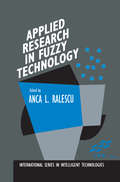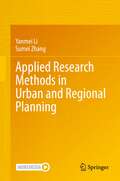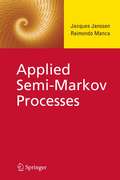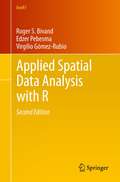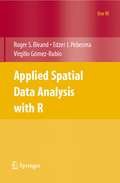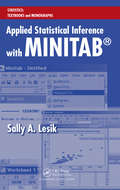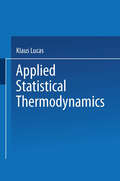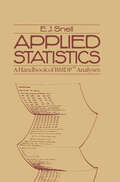- Table View
- List View
Applied Research in Fuzzy Technology: Three years of research at the Laboratory for International Fuzzy Engineering (LIFE), Yokohama, Japan (International Series in Intelligent Technologies #1)
by A. L. RalescuFuzzy logic is `a recent revolutionary technology' which has brought together researchers from mathematics, engineering, computer science, cognitive and behavioral sciences, etc. The work in fuzzy technology at the Laboratory for International Fuzzy Engineering (LIFE) has been specifically applied to engineering problems. This book reflects the results of the work that has been undertaken at LIFE with chapters treating the following topical areas: Decision Support Systems, Intelligent Plant Operations Support, Fuzzy Modeling and Process Control, System Design, Image Understanding, Behavior Decisions for Mobile Robots, the Fuzzy Computer, and Fuzzy Neuro Systems. The book is a thorough analysis of research which has been implemented in the areas of fuzzy engineering technology. The analysis can be used to improve these specific applications or, perhaps more importantly, to investigate more sophisticated fuzzy control applications.
Applied Research Methods in Urban and Regional Planning
by Yanmei Li Sumei ZhangThis book introduces the fundamentals of research methods and how they apply to the discipline of urban and regional planning. Written at a level appropriate for upper-level undergraduate and beginning master’s level students, the text fills a gap in the literature for textbooks on urban planning. Additionally, the book can be used as a reference for planning practitioners and researchers when analyzing quantitative and qualitative data in urban and regional planning and related fields.The volume does not assume advanced knowledge of mathematical formulas. Rather, it begins with the essentials of research methods, such as the identification of the research problems in planning, the literature review, data collection and presentation, descriptive data analysis, and report of findings. Its discipline-specific topics include field research methods, qualitative data analysis, economic and demographic analysis, evaluation research, and methods in sub-disciplines such as land use planning, transportation planning, environmental planning, and housing analysis. Designed with instruction in mind, this book features downloadable materials, including learning outcomes, chapter highlights, chapter review questions, datasets, and certain Excel models. Students will be able to download review questions to enhance the learning process and datasets to practice methods.
Applied Scientific Computing: With Python (Texts in Computer Science)
by Peter R. Turner Thomas Arildsen Kathleen KavanaghThis easy-to-understand textbook presents a modern approach to learning numerical methods (or scientific computing), with a unique focus on the modeling and applications of the mathematical content. Emphasis is placed on the need for, and methods of, scientific computing for a range of different types of problems, supplying the evidence and justification to motivate the reader. Practical guidance on coding the methods is also provided, through simple-to-follow examples using Python.Topics and features: provides an accessible and applications-oriented approach, supported by working Python code for many of the methods; encourages both problem- and project-based learning through extensive examples, exercises, and projects drawn from practical applications; introduces the main concepts in modeling, python programming, number representation, and errors; explains the essential details of numerical calculus, linear, and nonlinear equations, including the multivariable Newton method; discusses interpolation and the numerical solution of differential equations, covering polynomial interpolation, splines, and the Euler, Runge–Kutta, and shooting methods; presents largely self-contained chapters, arranged in a logical order suitable for an introductory course on scientific computing.Undergraduate students embarking on a first course on numerical methods or scientific computing will find this textbook to be an invaluable guide to the field, and to the application of these methods across such varied disciplines as computer science, engineering, mathematics, economics, the physical sciences, and social science.
Applied Semi-Markov Processes
by Jacques Janssen Raimondo MancaAims to give to the reader the tools necessary to apply semi-Markov processes in real-life problems. The book is self-contained and, starting from a low level of probability concepts, gradually brings the reader to a deep knowledge of semi-Markov processes. Presents homogeneous and non-homogeneous semi-Markov processes, as well as Markov and semi-Markov rewards processes. The concepts are fundamental for many applications, but they are not as thoroughly presented in other books on the subject as they are here.
Applied Simulated Annealing (Lecture Notes in Economics and Mathematical Systems #396)
by Rene V. V. VidalIn February 1992, I defended my doctoral thesis: Engineering Optimiza tion - selected contributions (IMSOR, The Technical University of Den mark, 1992, p. 92). This dissertation presents retrospectively my central contributions to the theoretical and applied aspects of optimization. When I had finished my thesis I became interested in editing a volume related to a new expanding area of applied optimization. I considered several approaches: simulated annealing, tabu search, genetic algorithms, neural networks, heuristics, expert systems, generalized multipliers, etc. Finally, I decided to edit a volume related to simulated annealing. My main three reasons for this choice were the following: (i) During the last four years my colleagues at IMSOR and I have car ried out several applied projects where simulated annealing was an essential. element in the problem-solving process. Most of the avail able reports and papers have been written in Danish. After a short review I was convinced that most of these works deserved to be pub lished for a wider audience. (ii) After the first reported applications of simulated annealing (1983- 1985), a tremendous amount of theoretical and applied work have been published within many different disciplines. Thus, I believe that simulated annealing is an approach that deserves to be in the curricula of, e.g. Engineering, Physics, Operations Research, Math ematical Programming, Economics, System Sciences, etc. (iii) A contact to an international network of well-known researchers showed that several individuals were willing to contribute to such a volume.
Applied Simulation and Optimization: In Logistics, Industrial and Aeronautical Practice
by Miguel Mujica Mota Idalia Flores De La Mota Daniel Guimarans SerranoPresenting techniques, case-studies and methodologies that combine the use of simulation approaches with optimization techniques for facing problems in manufacturing, logistics, or aeronautical problems, this book provides solutions to common industrial problems in several fields, which range from manufacturing to aviation problems, where the common denominator is the combination of simulation’s flexibility with optimization techniques’ robustness.Providing readers with a comprehensive guide to tackle similar issues in industrial environments, this text explores novel ways to face industrial problems through hybrid approaches (simulation-optimization) that benefit from the advantages of both paradigms, in order to give solutions to important problems in service industry, production processes, or supply chains, such as scheduling, routing problems and resource allocations, among others.
Applied Simulation and Optimization 2: New Applications in Logistics, Industrial and Aeronautical Practice
by Miguel Mujica Mota Idalia Flores De La MotaBuilding on the author’s earlier Applied Simulation and Optimization, this book presents novel methods for solving problems in industry, based on hybrid simulation-optimization approaches that combine the advantages of both paradigms. The book serves as a comprehensive guide to tackling scheduling, routing problems, resource allocations and other issues in industrial environments, the service industry, production processes, or supply chains and aviation. Logistics, manufacturing and operational problems can either be modelled using optimization techniques or approaches based on simulation methodologies. Optimization techniques have the advantage of performing efficiently when the problems are properly defined, but they are often developed through rigid representations that do not include or accurately represent the stochasticity inherent in real systems. Furthermore, important information is lost during the abstraction process to fit each problem into the optimization technique. On the other hand, simulation approaches possess high description levels, but the optimization is generally performed through sampling of all the possible configurations of the system. The methods explored in this book are of use to researchers and practising engineers in fields ranging from supply chains to the aviation industry.
Applied Soft Computing and Communication Networks: Proceedings of ACN 2023 (Lecture Notes in Networks and Systems #966)
by Jimson Mathew Sabu M. Thampi Jiankun Hu Ashok Kumar Das Shikha TripathiThis book constitutes thoroughly refereed post-conference proceedings of the International Applied Soft Computing and Communication Networks (ACN 2023) held at PES University, Bangalore, India, during December 18–20, 2023. The research papers presented were carefully reviewed and selected from several initial submissions. The papers are organized in topical sections on security and privacy, network management and software-defined networks, Internet of Things (IoT) and cyber-physical systems, intelligent distributed systems, mobile computing and vehicle communications, and emerging topics. The book is directed to the researchers and scientists engaged in various fields of intelligent systems.
Applied Soft Computing Technologies: The Challenge of Complexity (Advances in Intelligent and Soft Computing #34)
by Mario Köppen Bertram Nickolay Ajith Abraham Bernard De BaetsThis volume presents the proceedings of the 9th Online World Conference on Soft Computing in Industrial Applications, held on the World Wide Web in 2004. It includes lectures, original papers and tutorials presented during the conference. The book brings together outstanding research and developments in soft computing, including evolutionary computation, fuzzy logic, neural networks, and their fusion, and its applications in science and technology.
Applied Spatial Data Analysis with R (Use R! #10)
by Roger S. Bivand Edzer Pebesma Virgilio Gómez-RubioApplied Spatial Data Analysis with R, second edition, is divided into two basic parts, the first presenting R packages, functions, classes and methods for handling spatial data. This part is of interest to users who need to access and visualise spatial data. Data import and export for many file formats for spatial data are covered in detail, as is the interface between R and the open source GRASS GIS and the handling of spatio-temporal data. The second part showcases more specialised kinds of spatial data analysis, including spatial point pattern analysis, interpolation and geostatistics, areal data analysis and disease mapping. The coverage of methods of spatial data analysis ranges from standard techniques to new developments, and the examples used are largely taken from the spatial statistics literature. All the examples can be run using R contributed packages available from the CRAN website, with code and additional data sets from the book's own website. Compared to the first edition, the second edition covers the more systematic approach towards handling spatial data in R, as well as a number of important and widely used CRAN packages that have appeared since the first edition. This book will be of interest to researchers who intend to use R to handle, visualise, and analyse spatial data. It will also be of interest to spatial data analysts who do not use R, but who are interested in practical aspects of implementing software for spatial data analysis. It is a suitable companion book for introductory spatial statistics courses and for applied methods courses in a wide range of subjects using spatial data, including human and physical geography, geographical information science and geoinformatics, the environmental sciences, ecology, public health and disease control, economics, public administration and political science. The book has a website where complete code examples, data sets, and other support material may be found: http://www.asdar-book.org. The authors have taken part in writing and maintaining software for spatial data handling and analysis with R in concert since 2003.
Applied Spatial Data Analysis with R (Use R!)
by Roger S. Bivand Edzer J. Pebesma Virgilio Gómez-RubioWe began writing this book in parallel with developing software for handling and analysing spatial data withR (R Development Core Team, 2008). - though the book is now complete, software development will continue, in the R community fashion, of rich and satisfying interaction with users around the world, of rapid releases to resolve problems, and of the usual joys and frust- tions of getting things done. There is little doubt that without pressure from users, the development ofR would not have reached its present scale, and the same applies to analysing spatial data analysis withR. It would, however, not be su?cient to describe the development of the R project mainly in terms of narrowly de?ned utility. In addition to being a communityprojectconcernedwiththedevelopmentofworld-classdataana- sis software implementations, it promotes speci?c choices with regard to how data analysis is carried out.R is open source not only because open source software development, including the dynamics of broad and inclusive user and developer communities, is arguably an attractive and successful development model.
Applied Spatial Statistics and Econometrics: Data Analysis in R (Routledge Advanced Texts in Economics and Finance)
by Katarzyna KopczewskaThis textbook is a comprehensive introduction to applied spatial data analysis using R. Each chapter walks the reader through a different method, explaining how to interpret the results and what conclusions can be drawn. The author team showcases key topics, including unsupervised learning, causal inference, spatial weight matrices, spatial econometrics, heterogeneity and bootstrapping. It is accompanied by a suite of data and R code on Github to help readers practise techniques via replication and exercises. This text will be a valuable resource for advanced students of econometrics, spatial planning and regional science. It will also be suitable for researchers and data scientists working with spatial data.
Applied Spatial Statistics and Econometrics: Data Analysis in R (Routledge Advanced Texts in Economics and Finance)
by Katarzyna KopczewskaThis textbook is a comprehensive introduction to applied spatial data analysis using R. Each chapter walks the reader through a different method, explaining how to interpret the results and what conclusions can be drawn. The author team showcases key topics, including unsupervised learning, causal inference, spatial weight matrices, spatial econometrics, heterogeneity and bootstrapping. It is accompanied by a suite of data and R code on Github to help readers practise techniques via replication and exercises. This text will be a valuable resource for advanced students of econometrics, spatial planning and regional science. It will also be suitable for researchers and data scientists working with spatial data.
Applied Spatial Statistics for Public Health Data (Wiley Series in Probability and Statistics #368)
by Lance A. Waller Carol A. GotwayWhile mapped data provide a common ground for discussions between the public, the media, regulatory agencies, and public health researchers, the analysis of spatially referenced data has experienced a phenomenal growth over the last two decades, thanks in part to the development of geographical information systems (GISs). This is the first thorough overview to integrate spatial statistics with data management and the display capabilities of GIS. It describes methods for assessing the likelihood of observed patterns and quantifying the link between exposures and outcomes in spatially correlated data. This introductory text is designed to serve as both an introduction for the novice and a reference for practitioners in the field Requires only minimal background in public health and only some knowledge of statistics through multiple regression Touches upon some advanced topics, such as random effects, hierarchical models and spatial point processes, but does not require prior exposure Includes lavish use of figures/illustrations throughout the volume as well as analyses of several data sets (in the form of "data breaks") Exercises based on data analyses reinforce concepts
Applied Statistical Considerations for Clinical Researchers
by David CullifordThis essential book details intermediate-level statistical methods and frameworks for the clinician and medical researcher with an elementary grasp of health statistics and focuses on selecting the appropriate statistical method for many scenarios. Detailed evaluation of various methodologies familiarizes readers with the available techniques and equips them with the tools to select the best from a range of options. The inclusion of a hypothetical case study between a clinician and statistician charting the conception of the research idea through to results dissemination enables the reader to understand how to apply the concepts covered into their day-to-day clinical practice.Applied Statistical Considerations for Clinical Researchers focuses on how clinicians can approach statistical issues when confronted with a medical research problem by considering the data structure, how this relates to their study's aims and any potential knock-on effects relating to the evidence required to make correct clinical decisions. It covers the application of intermediate-level techniques in health statistics making it an ideal resource for the clinician seeking an up-to-date resource on the topic.
Applied Statistical Genetics with R: For Population-based Association Studies (Use R!)
by Andrea S. FoulkesStatistical genetics has become a core course in many graduate programs in public health and medicine. This book presents fundamental concepts and principles in this emerging field at a level that is accessible to students and researchers with a first course in biostatistics. Extensive examples are provided using publicly available data and the open source, statistical computing environment, R.
Applied Statistical Inference: Likelihood and Bayes
by Leonhard Held Daniel Sabanés BovéThis book covers modern statistical inference based on likelihood with applications in medicine, epidemiology and biology. Two introductory chapters discuss the importance of statistical models in applied quantitative research and the central role of the likelihood function. The rest of the book is divided into three parts. The first describes likelihood-based inference from a frequentist viewpoint. Properties of the maximum likelihood estimate, the score function, the likelihood ratio and the Wald statistic are discussed in detail. In the second part, likelihood is combined with prior information to perform Bayesian inference. Topics include Bayesian updating, conjugate and reference priors, Bayesian point and interval estimates, Bayesian asymptotics and empirical Bayes methods. Modern numerical techniques for Bayesian inference are described in a separate chapter. Finally two more advanced topics, model choice and prediction, are discussed both from a frequentist and a Bayesian perspective. A comprehensive appendix covers the necessary prerequisites in probability theory, matrix algebra, mathematical calculus, and numerical analysis.
Applied Statistical Inference with MINITAB
by Sally A. LesikThrough clear, step-by-step mathematical calculations, Applied Statistical Inference with MINITAB enables students to gain a solid understanding of how to apply statistical techniques using a statistical software program. It focuses on the concepts of confidence intervals, hypothesis testing, validating model assumptions, and power analysis.Illustr
Applied Statistical Inference with MINITAB®, Second Edition
by Sally A. LesikPraise for the first edition: "One of my biggest complaints when I teach introductory statistics classes is that it takes me most of the semester to get to the good stuff—inferential statistics. The author manages to do this very quickly….if one were looking for a book that efficiently covers basic statistical methodology and also introduces statistical software [this text] fits the bill." -The American Statistician Applied Statistical Inference with MINITAB, Second Edition distinguishes itself from other introductory statistics textbooks by focusing on the applications of statistics without compromising mathematical rigor. It presents the material in a seamless step-by-step approach so that readers are first introduced to a topic, given the details of the underlying mathematical foundations along with a detailed description of how to interpret the findings, and are shown how to use the statistical software program Minitab to perform the same analysis. Gives readers a solid foundation in how to apply many different statistical methods. MINITAB is fully integrated throughout the text. Includes fully worked out examples so students can easily follow the calculations. Presents many new topics such as one- and two-sample variances, one- and two-sample Poisson rates, and more nonparametric statistics. Features mostly new exercises as well as the addition of Best Practices sections that describe some common pitfalls and provide some practical advice on statistical inference. This book is written to be user-friendly for students and practitioners who are not experts in statistics, but who want to gain a solid understanding of basic statistical inference. This book is oriented towards the practical use of statistics. The examples, discussions, and exercises are based on data and scenarios that are common to students in their everyday lives.
Applied Statistical Inference with MINITAB®, Second Edition
by Sally A. LesikPraise for the first edition: "One of my biggest complaints when I teach introductory statistics classes is that it takes me most of the semester to get to the good stuff—inferential statistics. The author manages to do this very quickly….if one were looking for a book that efficiently covers basic statistical methodology and also introduces statistical software [this text] fits the bill." -The American Statistician Applied Statistical Inference with MINITAB, Second Edition distinguishes itself from other introductory statistics textbooks by focusing on the applications of statistics without compromising mathematical rigor. It presents the material in a seamless step-by-step approach so that readers are first introduced to a topic, given the details of the underlying mathematical foundations along with a detailed description of how to interpret the findings, and are shown how to use the statistical software program Minitab to perform the same analysis. Gives readers a solid foundation in how to apply many different statistical methods. MINITAB is fully integrated throughout the text. Includes fully worked out examples so students can easily follow the calculations. Presents many new topics such as one- and two-sample variances, one- and two-sample Poisson rates, and more nonparametric statistics. Features mostly new exercises as well as the addition of Best Practices sections that describe some common pitfalls and provide some practical advice on statistical inference. This book is written to be user-friendly for students and practitioners who are not experts in statistics, but who want to gain a solid understanding of basic statistical inference. This book is oriented towards the practical use of statistics. The examples, discussions, and exercises are based on data and scenarios that are common to students in their everyday lives.
Applied Statistical Learning: With Case Studies in Stata (Statistics and Computing)
by Matthias SchonlauThis textbook provides an accessible overview of statistical learning methods and techniques, and includes case studies using the statistical software Stata. After introductory material on statistical learning concepts and practical aspects, each further chapter is devoted to a statistical learning algorithm or a group of related techniques. In particular, the book presents logistic regression, regularized linear models such as the Lasso, nearest neighbors, the Naive Bayes classifier, classification trees, random forests, boosting, support vector machines, feature engineering, neural networks, and stacking. It also explains how to construct n-gram variables from text data. Examples, conceptual exercises and exercises using software are featured throughout, together with case studies in Stata, mostly from the social sciences; true to the book’s goal to facilitate the use of modern methods of data science in the field. Although mainly intended for upper undergraduate and graduate students in the social sciences, given its applied nature, the book will equally appeal to readers from other disciplines, including the health sciences, statistics, engineering and computer science.
Applied Statistical Methods: ISGES 2020, Pune, India, January 2–4 (Springer Proceedings in Mathematics & Statistics #380)
by David D. Hanagal Raosaheb V. Latpate Girish ChandraThis book collects select contributions presented at the International Conference on Importance of Statistics in Global Emerging (ISGES 2020) held at the Department of Mathematics and Statistics, University of Pune, Maharashtra, India, from 2–4 January 2020. It discusses recent developments in several areas of statistics with applications of a wide range of key topics, including small area estimation techniques, Bayesian models for small areas, ranked set sampling, fuzzy supply chain, probabilistic supply chain models, dynamic Gaussian process models, grey relational analysis and multi-item inventory models, and more. The possible use of other models, including generalized Lindley shared frailty models, Benktander Gibrat risk model, decision-consistent randomization method for SMART designs and different reliability models are also discussed. This book includes detailed worked examples and case studies that illustrate the applications of recently developed statistical methods, making it a valuable resource for applied statisticians, students, research project leaders and practitioners from various marginal disciplines and interdisciplinary research.
Applied Statistical Methods in Agriculture, Health and Life Sciences
by Bayo LawalThis textbook teaches crucial statistical methods to answer research questions using a unique range of statistical software programs, including MINITAB and R. This textbook is developed for undergraduate students in agriculture, nursing, biology and biomedical research. Graduate students will also find it to be a useful way to refresh their statistics skills and to reference software options. The unique combination of examples is approached using MINITAB and R for their individual strengths. Subjects covered include among others data description, probability distributions, experimental design, regression analysis, randomized design and biological assay. Unlike other biostatistics textbooks, this text also includes outliers, influential observations in regression and an introduction to survival analysis. Material is taken from the author's extensive teaching and research in Africa, USA and the UK. Sample problems, references and electronic supplementary material accompany each chapter.
Applied Statistical Thermodynamics
by Klaus LucasThe book guides the reader from the foundations of statisti- cal thermodynamics including the theory of intermolecular forces to modern computer-aided applications in chemical en- gineering and physical chemistry. The approach is new. The foundations of quantum and statistical mechanics are presen- ted in a simple way and their applications to the prediction of fluid phase behavior of real systems are demonstrated. A particular effort is made to introduce the reader to expli- cit formulations of intermolecular interaction models and to show how these models influence the properties of fluid sy- stems. The established methods of statistical mechanics - computer simulation, perturbation theory, and numerical in- tegration - are discussed in a style appropriate for newcom- ers and are extensively applied. Numerous worked examples illustrate how practical calculations should be carried out.
Applied Statistics: A Handbook of BMDP™ Analyses
by David CoxThis handbook is a realization of a long term goal of BMDP Statistical Software. As the software supporting statistical analysis has grown in breadth and depth to the point where it can serve many of the needs of accomplished statisticians it can also serve as an essential support to those needing to expand their knowledge of statistical applications. Statisticians should not be handicapped by heavy computation or by the lack of needed options. When Applied Statistics, Principle and Examples by Cox and Snell appeared we at BMDP were impressed with the scope of the applications discussed and felt that many statisticians eager to expand their capabilities in handling such problems could profit from having the solutions carried further, to get them started and guided to a more advanced level in problem solving. Who would be better to undertake that task than the authors of Applied Statistics? A year or two later discussions with David Cox and Joyce Snell at Imperial College indicated that a wedding of the problem statements and suggested solutions with control language to accomplish these analyses would further the learning process for many statisticians. They were willing to undertake the project. Joyce Snell has done an excellent job of melding the two approaches and has carried many of the problems a step further by suggesting alternate approaches and follow-up analyses.
